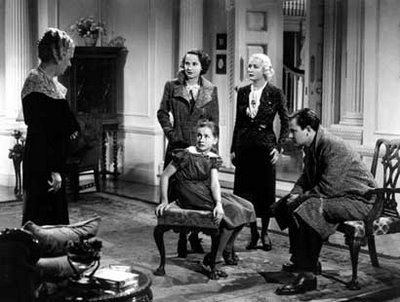 Oopsie doodle. StinkyLulu didn't expect to be so late with this entry but -- hey -- that's what happens when one ventures to the upper reaches of the Land of Enchantment: some conference hotels don't have internet access. (Imagine. So retro.) Speaking of retro...
Oopsie doodle. StinkyLulu didn't expect to be so late with this entry but -- hey -- that's what happens when one ventures to the upper reaches of the Land of Enchantment: some conference hotels don't have internet access. (Imagine. So retro.) Speaking of retro...'Twasn't that long ago that StinkyLulu and the Smackdowners contemplated another version of Lillian Hellman's The Children's Hour... Remember, lovely reader, way back in the golden days of July? When Fay Bainter proved quite a contender in 1961's Smackdown? Well, it's Hellman time again. Only this time, it's director William Wyler's 1936 go at the story (albeit sans sapphistry) and from which Oscar selected the first of many (how many is it? 8?) little girls to be nominated in this category...
approximately 27 minutes "on" screen
13 scenes (including 5 scenes under 1 minute)
31% of film's total screen time
13 scenes (including 5 scenes under 1 minute)
31% of film's total screen time
Granville -- who plays Mary Tilford, the awful little girl whose lies and innuendo nearly ruin the lives of These Three -- was a kid star of the old school. The daughter of actor parents, little Bonita had been acting for more than a decade by the time she (at age 12 or so) took on the part of Mary. Bonita Granville went on to act for most of her life, but it's for her performance here -- as well as her stint as the title character in a cinematic serialization of Nancy Drew -- that Granville is most remembered (though, surely, more people have seen her brief but memorable turn as Betty Davis' shallow niece in 1942's Now, Voyager).
The character of Mary Tilford is part indulged beast, part self-centered bully, part dispassionate sociopath -- Mary's a calculating menace both to those that love and those that loathe her. And Bonita Granville acquits the task efficiently. Indeed, Granville's Mary is most effective because she's so efficient, so cool, and so direct in her manipulations. Whether she's ensnaring her devoted grandmother in a skein of lies, or feigning friendship to a girl she plans to cruelly abuse in a moment's time, Granville's approach to the part is simple and direct, exceptionally understated in a dramatic scenario inclined to all kinds of hysterics. Indeed, Granville's Mary -- strangely subtle amidst the scenery chewing -- almost gets lost among the 1930s dramatics popping all 'round her.
A BRIEF ASIDE: It certainly doesn't help that, in many of her scenes, Granville's up against Marcia Mae Jones as everyone's favorite dim-witted kiddie klepto Rosalie. Quite simply, Jones' performance as Rosalie is one of the more electrifying kid performances Lulu's ever screened. With a wide-eyed pie-face just made for '30s cinematography, little Marcia Mae just wipes the floor with anyone, young or old, unfortunate enough to share the screen with her. The girl goes from shy to dumb to adamant to terrorized to hysterical -- all in the space of about 3 minutes, with intelligent clarity and thrilling precision. By far the best work in the film, Marcia Mae Jones' performance is reason enough to arrange a screening. And kid actresses should take note, what with Veronica Cartwright's excellent work in the 1961 version, Jones' scene-stealing should be a reminder that Rosalie is perhaps the coolest part in this enduring piece.
But there is one great moment in Bonita Granville's Mary that deserves especial note, a moment that subtly recalibrates the whole architecture of her entire performance: the penultimate beat of Mary's final scene. All her dissembling has been revealed and her grandmother, Mrs. Tilford, seems ready to keel over. Tilford's housekeeper, Agatha -- played by that snugglebunny Margaret Hamilton -- is charged with locking little Mary in her room. Mary tries to escape, but Agatha proves too swift, wrenches the child back to her and whallops her with a mighty slap. It's a shocking moment, made all the creepier by the glow that fills Granville's eyes as she regards Hamilton. Is it shock that someone would punish her? Relief that someone's finally taken her in hand? Or some creepier, other thing? (StinkyLulu votes for option 3.) This fleeting moment is the only glimpse that Granville provides of Mary without her mask and it's utterly enthralling. And it's proof positive that Bonita Granville was quite the little actress, entirely deserving of Oscar's nomination.




9 comments:
I may be having a schizo moment (at the beginning of the academic term, it's always possible), but another memorable thing about that Agatha/Mary slap at the end is that Agatha seems to call her "Amelia" before she hauls off and hits her. A weird gaffe, but gorgeously exploitable by all us close-reading types, no?
Thank you, thank you, for the Marcia Mae Jones kudos. Hers is emotionally true screen acting of the highest order (probably my favorite dramatic performance by a child, ever); in portraying hysteria few actors, be they old, young, or somewhere in between, have matched Jones for believability in her incredible "Solemn oath of a knight" or "I said it!!" scenes, and she serves as a perfect, sensitive counterpoint to Granville's flashy, nasty antics (as Granville piles torment and guilt on Rosalie's fragile psyche, you really start to hope for God to strike the little s--- dead, ala Patty McCormick in The Bad Seed, which makes-SPOILER ALERT-the brief "final showdown" between the two tykes a richly satisfying cinematic moment, as poor Rosalie finally gets a chance to offer a rebuttle to Granville's bullying).
It's a sensational, unforgettable performance, and I think Jones helped Granville gain the Oscar nod (Jones was mentioned alongside Granville in many reviews, and one reviewer stated the film contains "a terrified, brilliant performance by Bonita Granville." Really? I think Jones was the one scared witless throughout most of These Three. Although the entire cast is at the top of their games, in my mind Granville and the others play Jan Brady to Marcia, Marcia, Marcia's magnificent work.
If any of this sounds like hyberbole, just check out the movie (And, admittedly, Granville is great- of the five nominees, I'd go with her, with an asterisk attached for Jones' work).
And yep, Nick, you're right- Hamilton definitely refers to Mary by another name (I always thought she was saying "Bonita" instead of the character's name, while Wyler perhaps was thinking of lunchtime. Still, a great scene).
I haven't seen all of these performances, so sadly can't comment.
I've yet to toss the tape back in the machine but an extra wrinkle -- which is no secret -- is that Mrs. Tilford's first name is Amelia. SO: it could be that Amelia is one of the character Mary's many names OR it could be that Agatha's doing some Tilford-transferrance there...
Either way: it's a great moment, innovated for and unique to the 1936 version.
Haven't seen this, so I can't comment, but Jackie Cooper, in Skippy (1931), was the first child nominated in a competitive acting category, not Bonita Granville.
Duly noted & corrected.
Great blog - I love THESE THREE, too. When I was sixteen I had lunch with Margaret Hamilton and she told a great story about filming the slap scene. See link below:
http://hungrytigerpress.blogspot.com/2011/09/that-hamilton-woman.html
Thanks, Hungry Tiger!
That's a great story.
Post a Comment